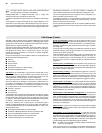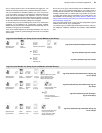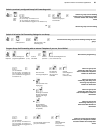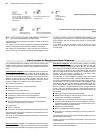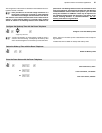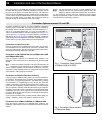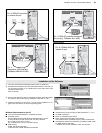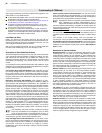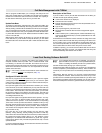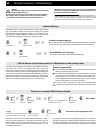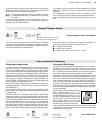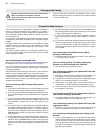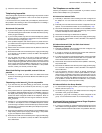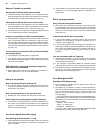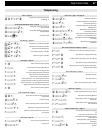
60 Functionality of COMtools
The program COMtools is a launcher for separate PC programs to use
with the PBX. You can select between:
˾ A Short-Code Dial Number editor. (You can enter the Short-Code
Dial Numbers and special numbers described later),
˾ A program to manage the Wake-up times (See chapter You like to
use the Wake-up Function of the PBX on page 35).
˾ A program to modify the Call Allowance accounts. You can also
review the charge unit sums for the subscribers (see chapter You
like to control Call Charges on page 31).
˾ A program for transfer of the internal Music on Hold, „Announce-
ment before Answering“ and internal announcements (.wav file) into
the PBX. You can also adjust the volume of the Music on Hold and
adjust various other Music on Hold functions.
Load Data and Store
Initially you should read the existing data from the PBX with the
launched program. Then you will get a list of internal subscribers for tel-
ephone book, Wake-up times and Call Allowance accounts. You can
now modify this transferred data from the PBX.
After you have modified the data file, you have to transfer these data
back to the PBX. Additionally you can save the data to a file.
Description of Short-Code Dial Numbers
The external telephone numbers that you often use can be saved under
a four digit Short-Code Dial Number to simplify the dialling. This four
digit Short-Code Dial Number will be dialled then instead of the
Exchange Line Access Number 0 + external number. The PBX will dial
automatically the Exchange Line Access Number and the stored
number.
If you activate the Short-Code Dial authorization with COMset for single
subscribers, these subscribers will be able to dial these Short-Code Dial
Numbers without exchange line permission.
User (private) Short-Code Dial Numbers: Each subscriber can have
up to twenty 20-digit numbers in the Short-Code number range 8200-
8219. These numbers will only be available to the telephone used for
programming. That means, you have to use the telephone for program-
ming the private Short-Code Dial Numbers that will be used later to
access these numbers.
Emergency Short-Code Dial Numbers: Enter Numbers as emer-
gency Short-Code Dial Number that should be available for dialling to
each subscriber with exchange line authorization. The permission to
dial these numbers is part of each exchange line authorization. Manda-
tory entries for the numbers are e.g. the emergency numbers of the fire
brigade and the police. The emergency numbers 110 and 112 are
stored in the default factory setting under 8110 and 8112. To save time
in a case of emergency, you can assign the entries in the emergency
Short-Code Dial memory to 2 or 3 digit numbers (10-59; 100-599), e.g.
with the number 110 (via configuration software COMset). The numbers
110 and 112 are assigned to 8110 and 8112 in the default factory set-
tings. That means, if you dial 110 on your telephone, the PBX automat-
ically dials the Short-Code Dial Number 8110 (Exchange Line Access
Number
0 + external number 110). The advantage is that even per-
sons without PBX experience or knowledge of Exchange Line Access
Numbers can dial these numbers without any problems. You can store
a maximum of 10 emergency numbers within a numbering range of
8110 to 8199.
The emergency call priority function provides an exchange
line at any circumstance for an emergency call or an alarm
call to an external number. If all exchange lines are busy, an
active call will be terminated in favour of the emergency call. Therefore,
do not enter any „general“ Short-Code Dial Numbers here.
Long (100-digit) Short-Code Dial Numbers: You can store a maxi-
mum of 10 long Short-Code Dial Numbers. You can choose from a num-
bering range of 8100 to 8109. In addition to a 20-digit dialling number
you can enter a short text, to be sent to e.g. a pager (e. g. SCALL,
D2-Message). Open the help file (Help...Topics) to view the character
options you have.
Public (common) Short-Code Dial Numbers: You can store a maxi-
mum of 400 public Short-Code Dial Numbers. You can choose from a
numbering range of 8600 to 8999. All subscribers with exchange line
authorization have the permission to dial these numbers.
The telephone book of a connected system telephone (COM-
fortel 1500/2500 and COMfort 1000/1200/2000 plus) is
merged with the telephone numbers (with name) entered into
the short-code dial number memory of the PBX. To use this function, the
short-code dial numbers with name should be entered with the program
COMtools telephone book
.
With the program COMtools telephone book
you can transfer some of
the short-code dial numbers of the PBX into the telephone book of a
connected system telephone COMfortel DECT 900 or COMfort DECT
800.
The numbers of the mobile phones used and authorized for
Call Through, have to be entered in COMtools as Public Short-Code
Dial Numbers with Call Through authorization. The number presen-
tation of the mobile phone must be activated. You can also configure in
COMtools for each individual mobile phone number if Blocking Num-
bers are used.
Description of special Numbers
Blocking Numbers: To limit the exchange line authorization of sub-
scribers/groups, you can enter up to 20 10-digit Blocking numbers.
These Blocking numbers can be activated for each individual sub-
scriber/group with the configuration program COMset. It is common use
to Blocking number with higher charges that are starting with a certain
number and should not be accessible to every subscriber e.g. the 0900-
numbers. The first 4 to 5 digits are significant for most high charge tel-
ephone services. Please keep in mind that all numbers beginning with
the numbers entered here are blocked. For example: If you enter „0“
only, all long distance calls would be blocked.
Release numbers: To extend the exchange line authorization of sub-
scribers/groups, you can enter up to 20 10-digit Release numbers.
These Release numbers can be activated for each individual sub-
scriber/group with the configuration program COMset. You can enter
here e.g. the number „0800“ to be available for subscribers without
exchange line authorization. The Release numbers have a higher prior-
ity than the blocking numbers, so you can deactivate Blocking numbers
or parts of blocking numbers (e.g. block 0900 numbers but release
09001 numbers). Please keep in mind that all numbers beginning with
the numbers entered here are released. For example: If you enter „0“
only, all long distance calls would be released.
VIP numbers: If you like to be reachable for special persons with your
activated „Do-Not-Disturb“ service, it will be possible to enter their exter-
nal telephone number into a VIP list with the PC software COMtools.
This VIP list is valid for all subscribers and you are able to activate or
deactivate it for your telephone if necessary (p. 30). The presentation of
the caller telephone number is necessary for the PBX to recognize the
caller. You can enter up to twenty 20-digit VIP numbers.
Robinson numbers: If you like not to be reachable for certain individ-
uals, it will be possible to enter their external telephone number into a
Robinson list with the PC software COMtools. This Robinson list is valid
for all subscribers and you are able to activate or deactivate it for your
telephone if necessary (p. 30). The presentation of the caller telephone
number is necessary for the PBX to recognize the caller. You can enter
up to ten 20-digit Robinson numbers. You are able to activate or deac-
tivate it for groups with the configuration program COMset.
Functionality of COMtools
☞
☞



